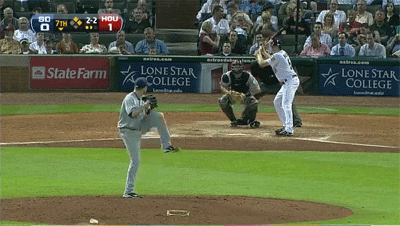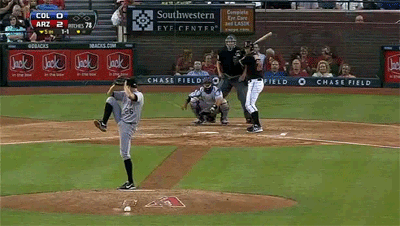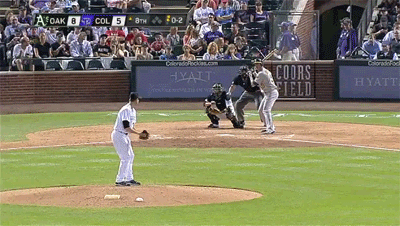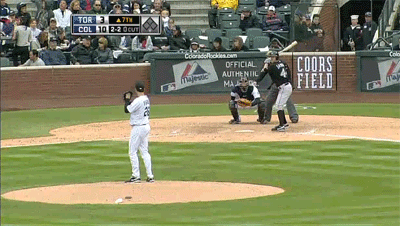On Wednesday night, Aroldis Chapman entered an 8-6 game in relief of an injured Jonathan Broxton, who faced two batters in the top of the eighth before his elbow cut his outing short. It was the first time Chapman had been asked to get more than three outs all season. And because a “distraught” Dusty Baker screwed up the double switch, Chapman also made his first major-league plate appearance in the bottom of the inning.
Chapman got a standing ovation from a super-excited Cincinnati crowd when he came to the plate. And unlike some closers who rarely hit—and whose health is much more important than the outcome of any one plate appearance—he wasn’t instructed not to swing. Chapman, who played first base in Cuba before he pitched and showed a decent swing, ran the count full and took two big cuts en route to a predictable strikeout. And then the fans sat back down.
There’s something simultaneously exhilarating and disillusioning about watching a late-inning reliever attempt to hit. Closers grow beards, wear goggles, and choose adrenaline-inducing entrance songs, all in an effort to psych themselves up and intimidate opponents. You’d think a closer would be even more intimidating when he’s holding a bat, but in practice the opposite is true. At first, it’s fun to see someone who usually strikes fear into batters getting a taste of the same treatment, much like it’s fun to see position players take the mound. But closers are worse at hitting than a selective sample of position players are at pitching, and they rarely put up much of a fight. By the time the at-bat is over, the closer’s aura of invincibility is flickering, and we’re wishing we could forget his feeble swings. It’s like the feeling a Russell Crowe fan gets after going from Gladiator to Les Mis.
Of the 30 closers listed in Mike Gianella’s most recent edition of the Bullpen Report, 21 have made at least one major-league plate appearance. Ten of those—Joe Nathan, Joaquin Benoit, Fernando Rodney, Rafael Soriano, LaTroy Hawkins, Rafael Betancourt, Chris Perez, Kevin Gregg, Koji Uehara, and Glen Perkins—made their most recent trip to the plate no later than 2009, which might as well be 1909 as far as internet availability of video is concerned. An 11th, Steve Cishek, saw one pitch last season and attempted a sacrifice bunt. That leaves us with 10 current closers with a swing we can watch. (Kenley Jansen, Edward Mujica, and Brad Ziegler are the only ones with hits.) Some of the plate appearances date from before these pitchers became certified closers, but we’ll assume that they’d look just as adequate or inept now.
I watched the most recent plate appearance for all 10 closers, capturing a screenshot of a stance and a GIF of a swing for each. Then I asked Jason Parks for a scouting report on those swings and ranked them in descending order of emasculation, from most to least futile:
10. Mark Melancon (April 14, 2011 vs. Dustin Moseley)
Stance: 
Points for being the only closer who went without batting gloves.
Swing: 
Parks Scouting Report: "I think this is the first time Melancon has ever held a baseball bat. The swing is unnatural and the feet don’t want to stay on the ground. His hips fire prematurely and his crotch is exposed before the ball even arrives. I’m not sure he could hit a ball off a tee with that swing."
9. Edward Mujica (August 11, 2013 vs. Michael Bowden)
Stance: 
Swing: 
Parks Scouting Report: "Nope. Corkscrewed; steps out to swing; drops his hands; poor swing; no chance."
8. Brad Ziegler (April 27, 2013 vs. Jeff Francis)
Stance: 
Ziegler's batting stance isn't as unorthodox as his delivery, but it has produced similar results: three balls in play, three groundballs.
Swing: 
Parks Scouting Report: "Creates a very large strike zone, and his swing is such that he has only a very small pocket in which he can strike the ball; timing is off; plane is very exaggerated; lots of effort and hard to control."
7. Grant Balfour (June 12, 2012 vs. Adam Ottavino)
Stance: 
Swing: 
Parks Scouting Report: "Balfour has a slow trigger and a bad swing, but his idiosyncratic traits are endearing and I’ll always support him as a result. He probably had a lengthy conversation with his bat, most likely involving profanity and perhaps the threat of physical violence."
6. Casey Janssen (June 13, 2010 vs. Jeff Francis)
Stance: 
Swing: 
Parks Scouting Report: "Lots of pre-swing movement; off time with the front foot; no chance of catching up to anything above his hands; hips look good; might be a good dancer; decent rip."
5. Mariano Rivera (June 23, 2010 vs. Carlos Rosa)
Stance: 
Swing: 
Parks Scouting Report: "First of all, I’ve never heard of Carlos Rosa. Secondly, Mo takes a unique approach to hitting live pitching by standing in the on-deck-circle during at-bats. He might as well take cuts from the bullpen. His biggest weakness is that baseballs scare him and he swings to protect himself. His greatest strength is that he has a kind heart and is a good listener. Also, every foul ball has cutter-like movement and departs the bat with integrity and Panamanian pride."
Here's a pictorial essay on Rivera's swing, starring Robinson Cano.
Before: 
During: 
After: 
4. Sergio Romo (April 26, 2010 vs. Antonio Bastardo)
Stance: 
Swing: 
Parks Scouting Report: "Leaks early and comes up on the backside; high hands and a good path into the zone; noisy and the trigger is long, which would limit his ability to catch up to velocity, especially above the hands, but he has bat speed once it gets moving."
3. Aroldis Chapman (August 21, 2013 vs. Brad Ziegler)
Stance: .png)
Swing: 
Parks Scouting Report: "Chapman swings the bat like he throws a baseball or drives an automobile in the evening hours: he grips it and rips it. I actually like the swing; it possesses well above-average violence and lift, and if he received a gift fastball, he could no doubt do some damage to the ball based on the intensity of his confident rip. However, because of the swing characteristics, Chapman stands no chance against movement, as the path of his swing doesn’t allow for any zone adjustment. Sometimes length isn’t a good thing."
2. Huston Street (April 8, 2011 vs. Chris Resop)
Stance: 
Swing: 
Parks Scouting Report: "Street shows Texas #want in the swing, a confidence and swagger that allows any physical limitation to play up; good hand position; good front foot timing; good barrel control; good overall strike."
1. Kenley Jansen (May 12, 2013 vs. Mike Dunn)
Stance: 
Swing: 
Parks Scouting Report: "Very comfortable looking in the box; good hand position; good timing; gets the front foot down; hard to square velocity in that location; testament to his ability to put the bat on the ball at all. Impressive, actually."
Thank you for reading
This is a free article. If you enjoyed it, consider subscribing to Baseball Prospectus. Subscriptions support ongoing public baseball research and analysis in an increasingly proprietary environment.
Subscribe now
I love most things JP writes but this is one of my all-time favorites: "every foul ball has cutter-like movement and departs the bat with integrity and Panamanian pride."